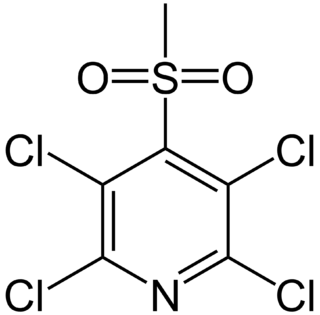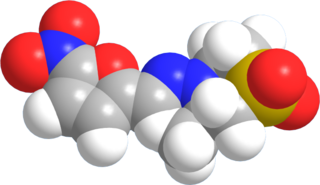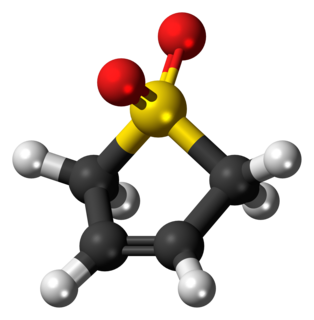 W
WA sulfone is a chemical compound containing a sulfonyl functional group attached to two carbon atoms. The central hexavalent sulfur atom is double-bonded to each of two oxygen atoms and has a single bond to each of two carbon atoms, usually in two separate hydrocarbon substituents.
 W
WAmenamevir is an antiviral drug used for the treatment of shingles.
 W
WBrinzolamide is a carbonic anhydrase inhibitor used to lower intraocular pressure in patients with open-angle glaucoma or ocular hypertension.
 W
WChlormezanone is a drug used as an anxiolytic and a muscle relaxant.
 W
WDavicil is a chlorinated pyridine derivative with antimicrobial properties, which is used as a fungicide. It can be allergenic in humans and produce contact dermatitis.
 W
WDibromodiethyl sulfone is a sulfone containing two 2-bromo-ethyl substituents.
 W
WDichlorodiethyl sulfone (or mustard sulfone) is an oxidation product of mustard gas. It has the formula (ClCH2CH2)2SO2. Although it is irritating to the eyes, it is not nearly as bad as mustard gas (dichlorodiethyl sulfide).
 W
WDorzolamide, sold under the brand name Trusopt among others, is a medication used to treat high pressure inside the eye including glaucoma. It is used as an eye drop. Effects begin within three hours and lasts for at least eight hours. It is also available as the combination dorzolamide/timolol.
 W
WEx-Rad is an experimental drug being developed by Onconova Therapeutics and the U.S. Department of Defense. It is being studied as a radiation protection agent. Chemically, it is the sodium salt of 4-carboxystyryl-4-chlorobenzylsulfone.
 W
WFlubendiamide is a pesticide in of the ryanoid class which acts at receptors in insect muscles. It is registered for use on over 200 crops, with some crops having as many as six applications per year.
 W
WIC-26 is an analogue of the opioid analgesic methadone, where the carbonyl group has been replaced by the bioisosteric sulfone group.
 W
WLapatinib (INN), used in the form of lapatinib ditosylate (USAN) is an orally active drug for breast cancer and other solid tumours. It is a dual tyrosine kinase inhibitor which interrupts the HER2/neu and epidermal growth factor receptor (EGFR) pathways. It is used in combination therapy for HER2-positive breast cancer. It is used for the treatment of patients with advanced or metastatic breast cancer whose tumors overexpress HER2 (ErbB2).
 W
WModafinil sulfone is an achiral, oxidized metabolite of modafinil, a wakefulness-promoting agent. It is one of two major circulating metabolites of modafinil, the other being modafinil acid. Modafinil sulfone is also a metabolite of the modafinil prodrug, adrafinil. Modafinil sulfone is also a metabolite of armodafinil, the (R)-(–)-enantiomer of modafinil, as oxidation to the sulfone removes the chiral center at the sulfur atom. Modafinil sulfone has been described as inactive, and similarly to modafinil acid, does not appear to contribute to the wakefulness-promoting/psychostimulant effects of modafinil. However, like modafinil, modafinil sulfone was found to show anticonvulsant properties in animals, indicating that it does possess some biological activity.
 W
WNarlaprevir, is an inhibitor of NS3/4A serine protease, intended for the treatment of chronic hepatitis C caused by genotype 1 virus) in combination with other antiviral drugs.
 W
WNifurtimox, sold under the brand name Lampit, is a medication used to treat Chagas disease and sleeping sickness. For sleeping sickness it is used together with eflornithine in nifurtimox-eflornithine combination treatment. In Chagas disease it is a second-line option to benznidazole. It is given by mouth.
 W
WOxycarboxin is an organic compound used as a fungicide.
 W
WPyroxasulfone is a pre-emergence herbicide that inhibits the production of very long chain fatty acids in plants. The structure of the existing herbicide thiobencarb served as the basis for development but pyroxasulfone requires a lower dose (100–25 g/ha) and is more stable resulting in longer efficacy. As of 2016 it had been registered for use in Japan, Australia, USA, Canada, Saudi Arabia and South Africa and was used on crops including maize, soybean, wheat and cotton. In 2015 it was applied to over 6 million hectares of land. Pyroxasulfone is from a novel chemical class but has a similar mode of action to acetamide herbicides such as metolachlor, acetochlor and dimethenamid. It is mainly used to control annual grasses but is also effective against broadleaf weeds including lambsquarters, pigweed and waterhemp and black nightshade
 W
WSulbactam is a β-lactamase inhibitor. This drug is given in combination with β-lactam antibiotics to inhibit β-lactamase, an enzyme produced by bacteria that destroys the antibiotics.
 W
WSulfolene, or butadiene sulfone is a cyclic organic chemical with a sulfone functional group. It is a white, odorless, crystalline, indefinitely storable solid, which dissolves in water and many organic solvents. The compound is used as a source of butadiene.
 W
WSulfonmethane is a chemical compound first synthesized by Eugen Baumann in 1888 and introduced as a hypnotic drug by Alfred Kast later on, but now superseded by newer and safer sedatives. Its appearance is either in colorless crystalline or powdered form. In United States, it is scheduled as a Schedule III drug in the Controlled Substance Act.
 W
WTazobactam is a pharmaceutical drug that inhibits the action of bacterial β-lactamases, especially those belonging to the SHV-1 and TEM groups. It is commonly used as its sodium salt, tazobactam sodium. In simple terms, it is an ingredient that can be added to certain antibiotics to make them less vulnerable to bacteria's antimicrobial resistance.
 W
WTetronal is a sedative-hypnotic and anesthetic drug with GABAergic actions. It is not as effective as trional.
 W
WTinidazole is a drug used against protozoan infections. It is widely known throughout Europe and the developing world as a treatment for a variety of amoebic and parasitic infections. It was developed in 1972 and is a prominent member of the nitroimidazole antibiotic class.
 W
WTrional (Methylsulfonal) is a sedative-hypnotic and anesthetic drug with GABAergic actions. It has similar effects to sulfonal, except it is faster acting.
 W
WVinyl sulfone dyes are reactive dyes comprising a vinyl sulfone group as reactive group (a fiber-bonding site of the reactive dye, "reactive hook"). Due to the relatively high reactivity of the vinyl sulfone group with water (residual moisture, air humidity), it is present in many commercial products in a protected form. For protection, an ethylsulfonyl group is substituted with a leaving group. During the dyeing process under alkaline conditions, the vinyl sulfone group is released by an elimination reaction: Formation of the vinyl sulfone group by alkaline elimination. R= alkyl or aryl radical, X=-OSO3H, -Cl
 W
WZiresovir is an antiviral drug which was developed as a treatment for respiratory syncytial virus. It acts as a fusion inhibitor, and has shown good results in Phase II clinical trials.